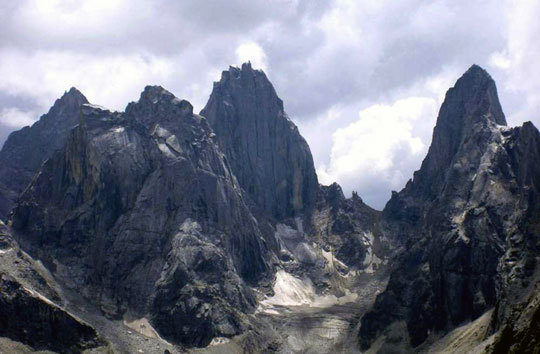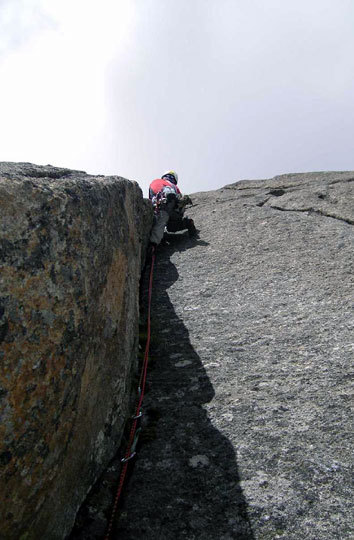
A view from the summit of Xie Xie (5.10a, 400m), Peak 4764m, Sichuan Province, China. Four Italians established this line August 22; this is one of many new ascents in the Valley, which has recieved a growing amount of attention over the last few years. The increased traffic is mostly due to the Chinese Governement’s attempts to spur tourist visits via the construction of roads and tourist facilities. [Photo] Courtesy of Elena Davila Merino
Four Italian climbers established a new alpine route on an unnamed peak (4764m) in the Changping Valley, Sichuan Province, China. The area received little attention until recently and contains a number of unclimbed, unnamed peaks. The team set up their base camp at the head of the valley, surrounded by 400- to 900-meter granite walls, team member Elena Davila Merino said, on which they planned to apply light and fast tactics to untouched terrain. They selected the southeast pillar of Peak 4764m as their objective, mostly due to the pleasing vertical face, 400 meters high, that appeared to house fantastic climbing. After some acclimatization hikes and one attempt on the peak foiled by bad weather, the team made a second, successful attempt.
The team left base camp on August 22 at 6 a.m., arriving at the route’s base at 8:30. After more than six hours of climbing, they reached the top of the unnamed peak via the southeast pillar. They named the route Xie Xie (5.10a A0, 400m), meaning “Thank You” in Chinese. A small amount of scrambling and one 60-meter rappel brought the team into a descent gully on the northwest face.
The Sichuan Mountaineering Association was of great assistance in obtaining climbing permits, liason officers and transportation into the region, the team reported.
The Changping Valley, located in China’s Sichuan Province, has seen little attention until relatively recently. The area was closed to westerners until 1984. Even after the lifting of the visitor ban, the area received only a handful of visits by climbers. A few peaks have been climbed by Chinese mountaineers, and some solo ascents were made by late American climber Charlie Fowler. The American Alpine Journal also records one trip to the valley by a Chinese/American team to climb waterfall ice.

Classic dihedral climbing on Xie Xie (5.10a A0, 400m), Peak 4764m, Sichuan Province, China. [Photo] Courtesy of Sean McCabe
In 1998, a governmental ban on logging in many regions of the country led local officials to seek out new revenue streams. They quickly decided upon tourism. This promotion of the region has led to significant new construction, most prominently the Jiuzhaigou Ring Way, a 930-kilometer road linking the area with Chengdu and the Jiuhuang Airport. Rilong, a nearby city, is undergoing major changes. The small mountain road from Chengdu to Rilong is under development. The government’s desire to increase the number of hotels and other tourist facilities has led to the compulsory removal of some residents of Rilong. Other changes already implemented are the reconstruction and expansion of a three-kilometer boardwalk system that leads into the main Changping Valley.
The World Wildlife Fund’s Chinese office reports that the increased construction and road building has led to fragmentation of wildlife habitat, particularly that of the endangered Giant Panda, and significantly increased tourist traffic in the nearby Wanglang National-level Nature Reserve in Sichuan’s Pingwu County. Despite the new ease of access, it is important for climbers to keep in mind the environmental and social impacts of their actions in any region they visit.